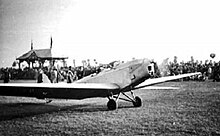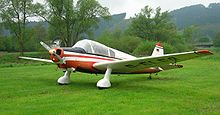Light aircraft construction Klemm
| Leichtflugzeugbau Klemm GmbH | |
|---|---|
| legal form | Company with limited liability |
| founding | 1926 |
| resolution | 1959 |
| Seat | Boeblingen , Germany |
| Branch | Aircraft manufacturer |
The light aircraft Klemm GmbH was a German aircraft manufacturer based in Böblingen .
history
founding

In 1926 Hanns Klemm went into business for himself and founded Leichtflugzeugbau Klemm GmbH in Böblingen. From 1927, Klemm manufactured the Daimler L20 under its own name as the Klemm L20. From the L 20, under the direction of Robert Lusser , the company's best-known aircraft emerged, the Klemm L 25 , which was later renamed Kl 25. It already produced over 600 units, with no fewer than 14 different types of engine installed. Licenses were issued to Great Britain and the USA. In 1929, the Klemm KL 26 was developed as a further development of the Klemm L 25 . This was followed by the Klemm Kl 31 and Klemm Kl 32 cabin aircraft .
Lusser's successor was Friedrich Fecher , who brought with him the composite construction preferred by the Technical Office of the Reich Aviation Ministry (RLM) and was responsible for the Klemm Kl 35 . With this aircraft, Hanns Klemm suffered a setback because the V 1 crashed in Rechlin with a broken wing, which was explained as a material defect, but in reality was probably due to overuse. Recalculations and strength tests showed that the regulations were met perfectly. Production could begin. The aircraft was then built in large numbers both at the main factory and by Fieseler and later by the Czech company Zlín for the Air Force. The Klemm Kl 36 designed for the European sightseeing flight in 1934 was also Fecher's work. In 1934, however, he went to the new Klemm branch in Halle , which was set up at the request of the RLM, as a senior designer , where he took the design for the twin-engine KL 104 touring aircraft with him. After the plant was renamed to Flugzeugwerk Halle (later Siebel Flugzeugwerke ), it became Fh 104.
The successor to Fechers in Böblingen was Carl Bucher , who came from the Bavarian Aircraft Works in Augsburg . He was responsible for all the Klemm aircraft that were built during the war, such as the Klemm Kl 105 , Klemm Kl 106 and Klemm Kl 107 as well as the Klemm Kl 151 and Klemm Kl 152 . In the period from 1936 onwards, Klemm developed a new type of production method in wood, the Klemm partial shell construction.
In 1943 the company was placed under state supervision and used to manufacture aircraft in metal ( Arado Ar 96 and finally Messerschmitt Me 163 ).
post war period
In the summer of 1952, during a conversation between Hanns Klemm, his son Hannsjürgen and other former members of the Leichtflugzeugbau Klemm company, the question was whether, after the general aircraft construction ban expected to be lifted in the near future, Klemm aircraft construction should be brought back to life . Klemm declared that he was no longer willing to actively participate due to his poor overall condition. The plan was pursued further and so in mid-1954 the group around Hannsjürgen Klemm started talks with Ludwig Bölkow and Wolf Hirth . In October, a preliminary contract for the establishment of a working group was concluded. In 1955, the revision of the plans of Kl 107 at Bölkow, which had been saved from the collapse, began by the newly arrived Carl Bucher. The prototype of the Kl 107 A built in Nabern first flew in the summer of 1956 with Karl Voy at the wheel. The Klemm-Flugzeug GmbH was founded by the Klemm GmbH and the Bölkow KG on October 18, 1957 for their sales . Two years later, on April 30, 1959, Bölkow took over the Klemm shares, so that from then on, production and sales were exclusively at Apparatebau Nabern GmbH , which was owned by Bölkow . The Klemm-Flugzeug GmbH was then dissolved. With the successor model of the Kl 107, version C, the Bölkow 207 derived from it , the name Klemm finally disappeared from the list of new registrations.
Production list
| designation | description | number of pieces |
|---|---|---|
| L 20 | Sports and training aircraft | about 80 |
| L 25 | Sport plane | about 600 |
| L 26 | School and sport aircraft | about 170 |
| Kl 31 | Touring plane | 30th |
| Kl 32 | Touring plane | 60 |
| Kl 33 | Ultralight sport aircraft | 1 prototype |
| Kl 35 | School and sport aircraft | over 1300 |
| Kl 36 | Touring plane | unknown |
| Kl 105 | Sports and touring aircraft | 11 |
| Kl 106 | Sport plane | 1 prototype |
| Kl 107 | Travel and training aircraft | 6 + 55 |
| Kl 151 | Touring plane | 1 |
literature
- Peter Supf : Hanns Klemm, the creator of the light aircraft . Three fountains, Stuttgart 1955.
- Peter W. Cohausz: German aircraft up to 1945: history, technology and locations of 3100 preserved historical aircraft . 5th edition. Aviatic Verlag, 2015, ISBN 978-3-942645-12-6 .
- Heinz J. Nowarra : The German Air Armament 1933-1945. Volume 3: Messerschmitt . Bernard and Graefe, Koblenz 1993, ISBN 3-7637-5467-9 .
Web links
Individual evidence
- ↑ Hanns Klemm founds the Klemm light aircraft construction company. In: mercedes-benz-publicarchive.com. M @ RS - The digital archive of Mercedes-Benz Classic, accessed on April 3, 2020 .
- ↑ a b c Life and work of Hanns Klemm. In: www.klemm-flieger-forum.de. Klemm-Flieger-Forum, accessed on April 3, 2020 .


